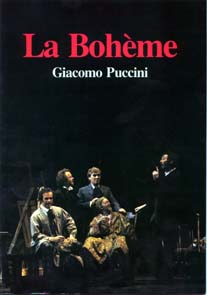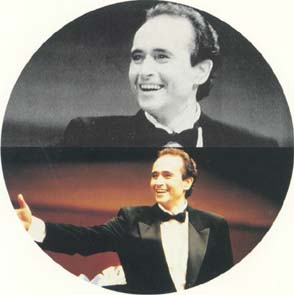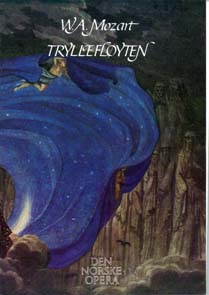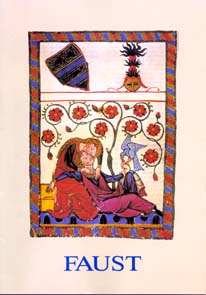1993-03-27 Samson et Dalila (Saint-Saëns), Opera Bergen
Dalila = Gail Gilmore
Samson = George Gray
Gran Pretre = Anooshah Golesorkhi
Abimelech = Boris Agayev
Anne Randine Øverby, conductor
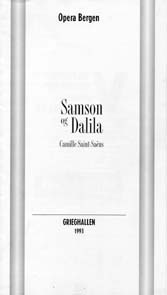
The Venue: Grieghallen, Bergen (Norway)
I know I was there but unfortunately I do not remember much from it. But I think I would have remembered if it had only been a concert version. I do think that I was impressed with Gail Gilmore's Dalila and by Anooshah Golesorkhi as Grand Pretre.
OD Travel
Tuesday, March 27, 2018
March 27, 1993: Samson et Dalila in Bergen
Posted by
operaduets
at
Tuesday, March 27, 2018
0
comments
![]()
Labels: 03_March, 03-27, 1993, Anooshah Golesorkhi, Bergen, CAMILLE SAINT-SAENS, Gail Gilmore, George Gray, Norway, Opera, SAMSON ET DALILA
Monday, March 19, 2018
March 19, 2005: Josep Carreras in Bergen
2005-03-19 Jose Carreras, Grieghallen (Bergen)
Josep Carreras, tenor
Nuovo Quartetto Italiano
Lorenzo Bavaj, piano
Jose Carreras first time in Bergen, Norway
For the first time in Bergen. Grieghallen March 19th, 2005. With him is string quartet Nuovo Quartetto Italiano and Lorenzo Bavaj on piano.
The End of Carreras Nordic Tour 2005.
Standing ovations and 6 extra numbers!!!!
PROGRAMME
Jose Carreras: Luna Nova (Mario Pasquale Costa)
Jose Carreras: Elegie (Jules Massenet)
Nuovo Quartetto Italiano: L'Ultima Canzone (Francesco Paolo Tosti)
Jose Carreras: Segreto (Francesco Paolo Tosti)
Jose Carreras: Sogno (Francesco Paolo Tosti)
Jose Carreras: Aprile (Francesco Paolo Tosti)
Nuovo Quartetto Italiano: Intermezzo (Respighi) (played Presto by Donizetti??)
Jose Carreras: T'estimo (Edvard Grieg)
Jose Carreras: O primavera (Pier Adolfo Tirindelli)
PAUSE
Jose Carreras: L'Oreneta (Enric Morera)
Jose Carreras: Andaluza (Enrique Granados)
Nuovo Quartetto Italiano: Scherzo (Giuseppe Verdi)
Jose Carreras: Na sera e maggio (Giuseppe Cioffi)
Jose Carreras: Firenze sogna (Cesar Cesarini)
Jose Carreras: Passione (Vincenzo Valente)
Nuovo Quartetto Italiano: Crisantemi (Giacomo Puccini)
Jose Carreras: Silenzo cantatore (Gaetano Lama)
Jose Carreras: Musica proibita (Stanislao Gastaldon)
JOSÉ CARRERAS
Lorenzo Bavaj, piano
Nuovo Quartetto Italiano
Grieghallen, Bergen 19.3.2005
Josep Carreras 9th time in Norway, and first time in Bergen. Almost 15 years after I saw Josep Carreras live for the first time I see him this time too in Norway. 14 years and 11 months on the date since his recital in Oslo Konserthus. This time a much better seat. This time also full house. But this is a great evening with standing ovation and 5 extra numbers. 15 years ago it was more the baroque arias, this time it is the more lighter songs of Tosti, Costa and so on. Of the more major composers Grieg and Massenet.
He started with LUNA NOVA by Costa, not my favorite piece and more of a warming up of voice piece. His voice is perfect for Massenet and his mastering of the French is superb. ELEGIE of Massenet was the first highlight of the concert. What a disappointment that L'ULTIMA CANZONE by Tosti was just played by the string quartet, where it became just a very minor classical piece. Josep Carreras came back to sing 3 more songs of Tosti, not really his best rendition of the song but sung with full passion more suited for opera arias, really. After Tosti the Nuovo Quartetto Italiano was supposed to play INTERMEZZO by Respighi but they played PRESTO by Donizetti (?!).
After the quartet had played Carreras came back and treated us with an exquisite rendition of Griegs JEG ELSKER DIG in Catalan T*ESTIMO. Sorry to say that the string quartet did not enhance the magic of this romance, but Lorenzo Bavaj and Josep Carreras gave it all the magic needed to take the breath away of the enchanted audience. The height of musicality was somewhat lowered in the O PRIMAVERA by Tirindelli but still it sounded almost like a major classical piece.
PAUSE.
The second part was really superior to the first. To sing the Catalan songs gave Carreras a boost that maybe already the romance of Grieg had given. L*ORONETA and especially ANDALUZA was magnificently sung. The string quartet was OK with Verdi's SCHERZO, but luckily when Carreras came back to sing Neapolitan songs as NA SERA MAGGIO, FIRENZE SOGNO and PASSIONE, all the passion the Catalan tenor used was justified and a mesmerized audience succumbed completely. At last the string quartet that had bothered us with it good but not great playing had found the piece right for the occasion Puccini's music where the magical music from his greatest opera, MANON LESCAUT was heard. At last there was some opera music. And the official program was ended with some of my favorite music, SILENTIO CANTATORE and MUSICA PROIBITA. And the audience was up on its feet, applauding and shouting BRAVO!!
And the we were treated with a tenor with lots of humor, gratefully to his Bergen audience. 6 extra numbers. This concert was a smash hit in Bergen.
EXTRA NUMBER
1. Un'Ombra (from PURE PASSION)
2. Coren'grato (CARDILLO)
3. Vurria
4. Un Núvol blanc (LLACH)
5. Neapolitan song about Winter
6. Santa Lucia
OD Travel + Photos
Posted by
operaduets
at
Monday, March 19, 2018
0
comments
![]()
Labels: 03_March, 03-19, 2005, Bergen, Concert, Josep Carreras, Norway
Friday, February 23, 2018
February 23, 2007: Il Barbiere di Siviglia in Oslo
2007-02-23 Il Barbiere di Siviglia (G. Rossini), Den Norske Opera
Almaviva = Juan José Lopera
Rosina = Virginia Tola
Figaro = Tom Erik Lie
Dr. Bartolo = Jonathan Veira
Don Basilio = Carsten Stabell
Berta = Toril Carlsen
Fiorello = Stevica Krajinonic
Ambrogio = Huw Reynolds
Notario / Rag doll = Martin Hasselgren
Police Officer = Petter Fegran
Tobias Ringberg, conductor
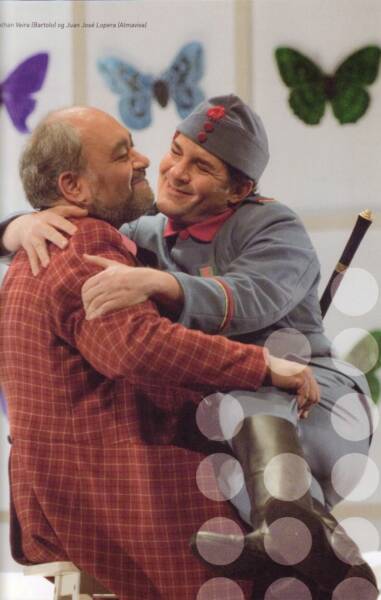
BARBEREN I SEVILLA
Opera i 2 akter av Gioacchino Rossini
- Libretto: Cesare Sterbini
Premiere: 23/2
Øvrige spilledager: 24/2,26/2, 28/2,1/3, 2/3, 3/3,4/3, 19/3, 22/3, 27/3
Spilletid: ca 2 t og 45 min
Fremføres på italiensk
Norske overtekster
Musikalsk ledelse: Tobias Ringberg
Regi: Francois de Carpentries
Dramaturg: Karine van Hercke
Scenografi: Emmanuel Clolus
Kostymer: Karine van Hercke
Lysdesign: Pierre Berthomé
Kormester: Steffen Kammler
Den Norske Operas kor
Den Norske Operas orkester
Produksjonen er et samarbeid med Opéra National de Lorraine, Nancy
The very famous ouverture beautifully played by the orchestra. At more than one occasion the orchestra stopped for so many seconds that a new listened would have thought the overture suddenly died. The conductor played the hammer-piano in the recitatives, although the singers were lively, the accompanist made so many extra thrills that it seemed to take forever until a new aria broke out and we could start enjoying ourselves again. But luckily the drama strong and very good comedy it was too.
Juan Jose Lopera was a wonderful Almaviva, wonderfully sung, acted. Tom Erik Lie was a very young Figaro, very enjoyable and humorous and a great voice. Doctor Bartolo was fully embodied with Jonathan Veira, a great singer and actor. Don Basilio was also wonderfully played and sung by Carsten Harboe Stabell. It was very sad that role of Berta has so little to sing but Toril Carlson sang Berta's aria wonderfully, what a wonderful warm soprano voice she has. Virginia Tola sang Rosina as mezzo soprano, beautiful sung and acted but she seemed to have a little voice compared to the other singers. Maybe she did not dare sing out too much.
The opera started at 1900 and ended at approx. 2200. And so my parents took the 2250 bus home. If we had come to late for that one, we would have to wait until 0050, 2 more hours.
The second act of il Barbiere was such a lot of fun, that I used many more muscles in my face than usual. "pace e gioia" . Juan Jose Lopera as the monk Don Alonso, hilarious...
February 2007: Il Barbiere in Oslo (2007-02-23)
OD Travel
Posted by
operaduets
at
Friday, February 23, 2018
0
comments
![]()
Labels: 02_February, 02-23, 2007, BARBIERE IN SIVIGLIA, Carsten Stabell, GIOACCHINO ROSSINI, Jonathan Veira, Juan Jose Lopera, Norway, Opera, Oslo, Tom Erik Lie, Virginia Tola
Friday, February 16, 2018
February 16, 2013: UN GIORNO DI REGNO in Kristiansund, Norway
For more reviews from my travels, see www.operaduetstravel.com If you want to see more photos from my OperaDuets Travels, go to www.operaduetsphotos.com
Posted by
operaduets
at
Friday, February 16, 2018
0
comments
![]()
Labels: 02_February, 02-16, 2013, Anna Einarsson, GIUSEPPE VERDI, Itziar Martinez Galdos, Kristian Krokslett, Kristiansund, Lars Eggen, Norway, Thomas Ruud, Trond Halstein Moe, UN GIORNO DI REGNO
Sunday, January 28, 2018
January 28, 1984: Die Lustige Witwe in Drammen
1984-01-28 Die Lustige Witwe (Lehar), Drammens Teater
Baron Mirko Zeta = Bjørn Lie-Hansen
Valencienne = Torhild Staahlen
Count Danilo Danilowitsch = Tor Fagerland
Hanna Glawari = Kjersti Ekeberg
Njegus = Ronald Rørvik
Camille de Rosillion = Caj Ehstedt
Vicomte Cascada = Frode Birkeland
Raol de St. Brioche = Kjell Kipperberg
Terje Boye Hansen, conductor
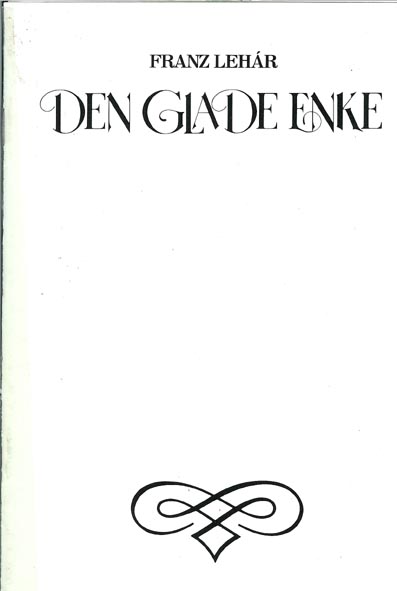
I was in Drammen's old Theatre before it burnt down and before it was reconstructed. And it was Die Lustige Witwe by Franz Lehar. I really loved it. My mother was worried about our car during the whole performance.
OD Travel
Posted by
operaduets
at
Sunday, January 28, 2018
0
comments
![]()
Labels: 01_January, 01-28, 1984, Caj Ehrstedt, Drammen, FRANZ LEHAR, Kjersti Ekeberg, LUSTIGE WITWE, Norway, Operetta, Terje Boje Hansen, Tor Fagerland, Torhild Staahlen
Thursday, January 25, 2018
January 25, 1990: Rosenkavalier in Oslo
1990-01-25 Der Rosenkavalier (R.Strauss), Den Norske Opera (Oslo)
Fyrstinne Werdenberg = Frøydis Klausberger
Baron Ochs von Lerchernau = Oddbjørn Tennfjord
Octavian = Sylvia Lindenstrand
Herr von Faninal = Jan Sødal
Sophie = Toril Carlsen
En sanger = Kjell Magnus Sandve
Heinz Fricke, conductor

They were great. Especially the women.
OD Travel
Posted by
operaduets
at
Thursday, January 25, 2018
0
comments
![]()
Labels: 01_January, 01-25, 1990, DER ROSENKAVALIER, Frøydis Klausberger, Heinz Fricke, Kjell Magnus Sandve, Norway, Opera, Oslo, RICHARD STRAUSS, Sylvia Lindenstrand, Toril Carlsen
Tuesday, January 23, 2018
January 23, 1989: La Boheme in Oslo
1989-01-23 La Boheme (Puccini), Den Norske Opera (Oslo)
Mimi = Solveig Kringlebotn
Musetta = Ingjerd Oda Mantor
Rodolfo = José Antonio Sempere
Marcello = Trond Halstein Moe
Schaunard = Per Vollestad
Colline = Svein Carlsen
Benoit/Alcindoro = Bjørn Lie-Hansen
Parpignol = Ola S. Isene
Per Åke Andersson, conductor
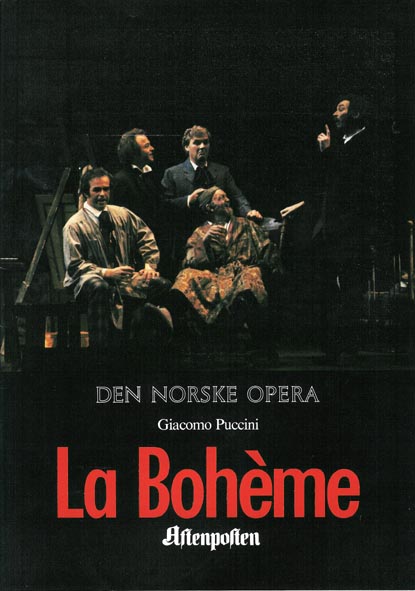
Solveig Kringlebotn (or Kringelborn as she is knowm internationally) and José Antonio Sempere was great as Mimi and Rodolfo.
OD Travel
Posted by
operaduets
at
Tuesday, January 23, 2018
0
comments
![]()
Labels: 01_January, 01-23, 1989, BOHEME, GIACOMO PUCCINI, Ingjerd Oda Mantor, José Antonio Sempere, Norway, Opera, Oslo, Per Åke Andersson, Per Vollestad, Solveig Kringlebotn, Trond Halstein Moe
Monday, January 15, 2018
January 15, 1993: La Traviata in Bergen
1993-01-15 La Traviata (Verdi), Den Norske Opera in Bergen
Violetta Valéry = Ingjerd Oda Mantor
Flora Bervoix = Torill Eriksen
Alfredo Germont = Kjell Magnus Sandve
Annina = Eva Solheim
Georgio Germont = Trond Halstein Moe
Gaston, Viscomte de Utorires = Mikael Fagerholm
Barone Duphol = Jens Olai Justvik
Marchese d'Obigny = Bjørn Mørch Olsen
Dottore Grenvil = Bjørn Lie-Mansen
Giuseppe, servo di Violetta = Giuseppe Chiarello
Terje Boye Hansen, conductor
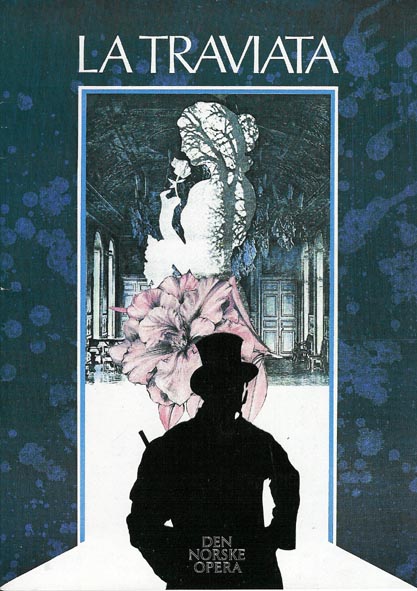
I lived in Bergen at this time. I guess it was an OK opera night
First I do not remember if it was January 13, 14, 15.
I was having my second job or was between jobs. Living close to the concert hall (Grieghallen) it was easy to get tickets.
I remember enjoying seeing this opera production again with other singers.
Den Norske Opera, Bergen Grieghallen
Conductor: Terje Boye Hansen
Regie: Jens Christian Ek
Scenography: Madla Bruza
Coreography: Frederic Konrad
Violetta Valéry: Elena Brilova 14/1,16/1
Ingjerd Oda Mantor 15/1
Flora Bervoix: Torill Eriksen
Alfredo Germont: Kjell Magnus Sandve
Annina: Eva Solheim
Georgio Germont: Jan SødaI14/1, 16/1
Trond Halstein Moe 15/1
Gaston, Viscomte de Utorires: Mikael Fagerholm
Barone Duphol: Jens Olai Justvik
Marchese d'Obigny: Bjørn Mørch Olsen
Dottore Grenvil: Bjørn Lie-Mansen
Giuseppe, servo di Violetta: Giuseppe Chiarello
Domestico di Flora: Birger Barring
Commissionario: Roald Nygard
Den Norske Operas Chorus
Bergen Filharmoniske Orkester
OD Travel
Posted by
operaduets
at
Monday, January 15, 2018
0
comments
![]()
Labels: 01_January, 01-15, 1993, Bergen, GIUSEPPE VERDI, Ingjerd Oda Mantor, Kjell Magnus Sandve, Norway, Opera, Terje Boje Hansen, Torill Eriksen, TRAVIATA, Trond Halstein Moe
Sunday, January 7, 2018
January 7, 1989: Die Fledermaus in Oslo
1989-01-07 Die Fledermaus (Johann Strauss), Den Norske Opera (Oslo)
Dr. Falke = Terje Stensvold
Alfred = Ragnar Ulfung
Adele = Solveig Kringlebotn
Rosalinde = Helena Döse
Eisenstein = Arild Helleland
Dr. Blind = Tor Gilje
Frank = Stein Arild Thorsen
Orlovski = Vesla Tveten
Ida = Gro Hundvin Eliassen
Frosch = Rolv Wesenlund
Zdenka Perharda, conductor
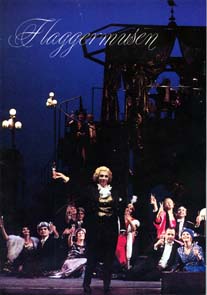
19 years after the performance, I say:
This operetta, The Bat (Die Fledermaus) is often played on New Years Eve or Day. Afterall it has a tune for Champagner as the King of Wine. This production was known for having Rolv Wesenlund, the famouse Norwegian comedian as Frosch. He is famous in Norway and Sweden. The old tenor master, Ragnar Ulfung sang Alfred and Swedish soprano Helena Döse was his wife. The new and now famous Norwegian soprano, Solveig Kringlebotn (or Solveig Kringelborn as she is called when she sings outside Scandinavia) was a wonderul Adele.
The operetta was upgraded to be set in the 1930's. Something that neither harmed it or enhanced it.
OD Travel
Posted by
operaduets
at
Sunday, January 07, 2018
0
comments
![]()
Labels: 01_January, 01-07, 1989, FLEDERMAUS, Helena Döse, JOHANN STRAUSS Jr, Norway, Operetta, Oslo, Ragnar Ulfung, Solveig Kringlebotn, Terje Stensvold, Zdenka Perharda
Saturday, December 30, 2017
December 30, 2010: Tosca in Oslo
2010-12-30 Tosca (G. Puccini), Den Norske Opera & Ballett
Floria Tosca = Maria Guleghina
Mario Cavaradossi = Miroslav Dvorsky
Scarpia = Greer Grimsley
Sakristanen = Ketil Hugaas
Angelotti = Yngve André Søberg
Sciarrone = Andreas Franzén
Spoletta = David Fielder
Fangevokter = Øystein Skre
Gjetergutt = Henrik Enger Holm
Dommer = Steinar Zahl
Roberti = Øivind Solberg4
John Helmer Fiore, conductor
Regie - Paul Curran
Scenography / costumes - Kevin Knight
Light design - David Jacques
Cooperation with Canadian Opera Company
Music Giacomo Puccini
Libretto: Giuseppe Giacosa og Luici Illica
This production premiered by Canadian Opera Company 26. January 2008, Norwegian National Opera 26. August 2010.
Almost New Year's Eve in the Opera. Tosca is one of my favorite operas, and Maria Guleghina is one of my favorite opera singers. I sat in 3rd Balcony almost in the middle. I could see the whole stage all the time.
Paul Curran had the Regie for this Tosca. It was a traditional production with much attention to the details. Puccini's music had already decided much of the timing and the action. Naturally it is hard to get all the details right in every performance. But for the first time I noticed that Puccini had put Angelotti's heavy breathing when he finally was in the church and could relax, when he composed it. It is unfortunately that many directors seem to overlook these clues in the music when they make their "regie". What we now often call Regie-Theater is neither Regie nor Theater, it is a director creating his own play while ignoring most of what would make the opera or theater a living breathing truth appearing before our eyes. So this Tosca production proves that a tradional setting of an opera, where one put it in context and in its own time need not be Old and Boring.
Attention to detail made Tosca real and interesting. From the beginning when Angelotti came in exhausted and till Tosca leapt to her death it was all believable and interesting. And the music was excellent, singers, orchestra was all together to make it opera-magic. Not one person on stage was un-real. But only in the movies could you make sure that everything would happen on the right Puccini note. This was real theater, no editing of false moves was possible. I think it must be absolutely impossible in a theater to close the door at the precise time at the cantata in act 2. Impossible! But it was so close that I would say that the impossible was achieved.
It is seldom one really feel that Cavaradossi and the Sagrestano is really preparing the colors when Cavaradossi sings "Recondita armonia" but of course here one knows it. Miroslav Dvorsky was a Cavaradossi who was really a painter, a revolutionary, a lover of Tosca, a smart man. The interaction of Cavaradossi with Angelotti was also interesting with Angelotti recognizing Cavaradossi and hugs him, but the painter does not recognized him and rejects him to the floor. So real... But then Cavaradossi understands that it is Angelotti who has escaped prison and promise to help him even it can mean his death, which in the end it does.
Mario Cavaradossi still has his head with him even if Angelotti looses his wits and his bags of women's cloths. He picks the bag up but misses the fan. Again something we seldom see so clearly as in this production. Tosca comes. Maria Guleghina is Tosca and one does fall for her spell. Paul Curran had made his choices in how to portray the relation of Cavaradossi and Tosca. I might disagree about making Tosca a little too fickle but when it works and really has foundation in the opera, then it can be true, too. This production is the first production I have seen where Tosca not only comes with flowers but also lays jewels at the Madonna. Attention to details is everywhere in this production. How happy I am to see a Tosca performance where the timing of when Tosca notices la Marchesa Attavanti is the Maddalena that Cavaradossi is painting, is correct.
It was a lovely love duet between Miroslav Dvorsky and Maria Guleghina.
The situation that Angelotti is in, is grave. It is serious business, and when Tosca has left and Angelotti and Cavaradossi meets again, Cavaradossi is taking care of things not like it is only theater but as a life and death situation. They leave. The Sagrestano comes in with a lot of people. And there is a Baccano in chiesa. As a lively scene play out with children, priests, nuns, men and women, the stage is prepared for the Te Deum with women taking the paper bits that Tosca teared up the Cavaradossi drawing of Attavanti, and priests takes away the painter's things. Everything that happens on the stage seem natural and organic... Then Scarpia and his minions appears. It is true as the opera says that this Scapia is feared by Rome's inhabitants. Even the children knows that this is a dangerous man. His minions is also recognized as unfriendly and to be feared. They are all relieved to be allowed to go. But the poor Sagrestano must stay. When Scarpia seem to forget him for a moment, he tries to escape, but the Scarpia's minion's punished the Sagrestano with violence in a corner of the church. Scarpia care not for him. Then Tosca comes in looking for Cavaradossi and the Sagrestano mocks her and is seized by Scarpia's men and pulled away. Scarpia stalks her, pretending to want to offer her Holy Water. Scarpia had planned this since he understood that Cavaradossi, Tosca's lover, was involved in the Angelotti affair. Tosca's jealousy was roused by Attavanti's fan that Scarpia supposedly found with the painter's things. When Tosca leaves Scarpia arrange for 3 spies and one vehicle to follow Tosca. The Te Deum is in progress, an impressive affair. This Scarpia leaves then by almost crashing the whole procession.
Act 2. The best Vissi d'arte ever.
Act 3. A wonderful E lucevan le stelle and a perfect Love Duet by Miroslav Dvorsky and Maria Guleghina.
What can I say? It was perfect.
OD Travel + Photos
Original blog post
For more reviews from my travels, see www.operaduetstravel.com If you want to see more photos from my OperaDuets Travels, go to www.operaduetsphotos.com
Posted by
operaduets
at
Saturday, December 30, 2017
0
comments
![]()
Labels: 12_December, 12-30, 2010, GIACOMO PUCCINI, Greer Grimsley, Maria Guleghina, Miroslav Dvorsky, Norway, Opera, Oslo, TOSCA
Friday, December 29, 2017
December 29, 1990: La Boheme in Oslo
1990-12-29 La Boheme (Puccini), Den Norske Opera (Oslo)
Mimi = Katia Ricciarelli
Musetta = Ingjerd Oda Mantor
Rodolfo = Richard Greaer
Marcello = Trond Halstein Moe
Schaunard = Stein Arild Thorsen
Colline = Svein Carlsen
Benoit/Alcindor = Eivind Bøksle
Antonio Pappano, conductor
OD Travel
For more reviews from my travels, see www.operaduetstravel.com
If you want to see more photos from my OperaDuets Travels, go to www.operaduetsphotos.com
Posted by
operaduets
at
Friday, December 29, 2017
0
comments
![]()
Labels: 12_December, 12-29, 1990, BOHEME, GIACOMO PUCCINI, Ingjerd Oda Mantor, Katia Ricciarelli, Norway, Opera, Oslo, Richard Greaer, Trond Halstein Moe
Thursday, December 28, 2017
December 28, 2010: Tosca in Oslo
2010-12-28 Tosca (G. Puccini), Den Norske Opera & Ballett
Floria Tosca = Maria Guleghina
Mario Cavaradossi = Miroslav Dvorsky
Scarpia = Greer Grimsley
Sakristanen = Ketil Hugaas
Angelotti = Yngve André Søberg
Sciarrone = Andreas Franzén
Spoletta = David Fielder
Fangevokter = Øystein Skre
Gjetergutt = Henrik Enger Holm
Dommer = Steinar Zahl
Roberti = Øivind Solberg
John Helmer Fiore, conductor
Regie - Paul Curran
Scenography / costumes - Kevin Knight
Light design - David Jacques
Cooperation with Canadian Opera Company
Music Giacomo Puccini
Libretto: Giuseppe Giacosa og Luici Illica
Cooperation with Canadian Opera Company.
This production premiered by Canadian Opera Company 26. January 2008, Norwegian National Opera 26. August 2010.
Both Greer Grimsley (Scarpia) and Miroslav Dvorsky (Cavaradossi) seemed to have been affected by the cold weather but Maria Guleghina (Tosca) was as her usual self. I was sitting on 3rd balcony on the right side. I could see more of the stage than on December 19 when I sat on Parkett right. From the beginning I could hear that Miroslav Dvorsky was not in his best form but that did but that did not hinder him from singing a fine Recondita armonia and an exceptional E lucevan le stelle. Only in the last duet it happened he lost his voice painfully. Luckily at his side a great collegue, Maria Guleghina who grasped his hands and comforted the tenor with her presence and her big voice and as a miracle the tenor found his voice back and that made the last duet even more moving. Tenor and soprano make it part of the opera. It was a happy opera night for Maria Guleghina who sang one of he finest Vissi d'arte. Maria Guleghina's interpretation of Tosca is always something to admire. She put her heart and soul into every part she sings. At this moment it is her Tosca and her Abigaille that I most admire.
After the opera I found the stage entrance and I went in to wait for my idol. I was alone, people left the opera house and there she was, the Diva with her beautiful assistant. Maria Guleghina and I are friends on Facebook but I never thought the Diva would look at me and say "it is your birthday, isn't it?". And then she sang me Happy Birthday in a natural, un-operatic way. And her assistant took a photo of me with Maria on my Birthday. O lucky day!
For more reviews from my travels, see www.operaduetstravel.com If you want to see more photos from my OperaDuets Travels, go to www.operaduetsphotos.com
Posted by
operaduets
at
Thursday, December 28, 2017
0
comments
![]()
Labels: 12_December, 12-28, 2010, GIACOMO PUCCINI, Greer Grimsley, Maria Guleghina, Miroslav Dvorsky, Norway, Opera, Oslo, TOSCA
Wednesday, December 27, 2017
December 27, 2011: Macbeth in Oslo, Norway
2011-12-27 Macbeth (Verdi), Den Norske Opera & Ballet (Oslo)
Macbeth = Claudio Sgura
Lady Macbeth = Itziar Martinez Galdos
Banquo = Magne Fremmerlid
Macduff = Daniel Johansson
Malcolm = Brenden Gunnell
Kammerdame = Christel Elisabeth Smith
Lege = Jens-Erik Aasbø
Macbeths tjener = Natanael Vasile Uifalean
En morder = Østein Skre
Duncan = Roald Nygård
Fleance, Banquos sønn = Sondre Paalgaard
John Helmer Fiore, conductor
Den Norske Opera & Ballet
Director - Stein Winge
Scenography and costumes - Tine Schwab
Lighting design - Frank Evin
The director was Stein Winge with scenography and costumes by Tine Schwab. This production of Macbeth by Verdi was neither a scandal nor a dramatic tragedy. Neither, a sad word. It was good but not great. It was a production that managed the scenes with the witches well but did not manage to make us (or at least me) care about the characters.
The magnificent bass Magne Fremmerlid was Banquo and did a superb job. The young Italian baritone Claudio Sgura was Macbeth. The singing of Sgura was great, his acting too, but he was not given a big palette to draw from. Stein Winge's idea made Macbeth from first note a flawed and weak man, and so he was from beginning to end. Lady Macbeth was sung by Itziar M. Galdos, who started weak but ended with a breathtaking sleepwalking scene. Brava!! But in the first aria of Lady Macbeth Stein Winge made her go from one side of the stage to the other aimlessly, so against the music and the words, not wonder Itziar M. Galdos even sounded unfocused. Luckily from the first aria she was simply better and better. The whole house should have stood up and cheered after the sleep walking scene but then Claudio Sgura was onstage and it was in so many ways Claudio's show. Daniel Johansson was Macduff and his rendition of Macduff's aria was one the best I have ever heard.
What is the problem with Macbeth, the opera of Verdi? Usually one talks of the supernational elements, the witches, and that Verdi was not his best in this elements. But in this production those scenes worked well. Some critics disliked the fact that it was just women in anoraks, but I disliked the laughter of the witches. The main thing was that it worked. The way Stein Winge incorporated the witches and some symbolic in the rest of the opera was exciting. He made us think that some of the women (all) of the royal court was also witches.
The King Duncan is no virtuos man if one is going by the way he imposes himself on the Lady Macbeth and jovially "Macbetto!!" to Macbeth and gives Macbeth a medaille. As all goes to the party, Macbeth remains alone. Why? Because in this production Macbeth is essentially a loner? Or just because the opera has to go on. Macbeth has many of these loner moments, or just laying down passively, or fainting. Who can care for this man? Does the Lady? Is she really the strong one of the two? Who is Lady Macbeth and what is her motivation? The portraits of Macbeth and his Lady are just skin deep, so the opera is boring but the music is glorious. The scene from Macduff comes to wake up the King, the murder and procession of the dead body of Duncan is just glorious. A highlight.
It is sad to see so many opera dirctor is doing the same thing, in Macbeth a refugee choir with their photos of loved ones. I started to think about copyright, whose photos and was permission given to use these photos in this way. Frankly I found it disrespectful. And was there even a need to use photos, no, I think we would have understood the plight of refugees without it.
For more reviews from my travels, see www.operaduetstravel.com If you want to see more photos from my OperaDuets Travels, go to www.operaduetsphotos.com
Posted by
operaduets
at
Wednesday, December 27, 2017
0
comments
![]()
Labels: 12_December, 12-27, 2011, Claudio Sgura, Daniel Johansson, GIUSEPPE VERDI, Itziar Martinez Galdos, MACBETH, Magne Fremmerlid, Norway, Opera, Oslo
Tuesday, December 19, 2017
December 19, 2010: Tosca in Oslo
2010-12-19 Tosca (G. Puccini), Den Norske Opera & Ballett
Floria Tosca = Maria Guleghina
Mario Cavaradossi = Miroslav Dvorsky
Scarpia = Greer Grimsley
Sakristanen = Ketil Hugaas
Angelotti = Yngve André Søberg
Sciarrone = Andreas Franzén
Spoletta = David Fielder
Fangevokter = Øystein Skre
Gjetergutt = Henrik Enger Holm
Dommer = Steinar Zahl
Roberti = Øivind Solberg
John Helmer Fiore, conductor
Regie - Paul Curran
Scenography / costumes - Kevin Knight
Light design - David Jacques
Cooperation with Canadian Opera Company
Music Giacomo Puccini
Libretto: Giuseppe Giacosa og Luici Illica
Cooperation with Canadian Opera Company.
This production premiered by Canadian Opera Company 26. January 2008, Norwegian National Opera 26. August 2010.
On December 19th, 2010 it was matinee at 1500. It was Maria Guleghina first time as Tosca at Norwegian National Opera, Oslo. It was the fourth time for me since I have earlier seen her as Tosca at Vienna State Opera, Deutsche Oper Berlin and Opernhaus Zurich.
I loved the production by regisseur Paul Curran. It was as historical as an opera can be. I sat on right so I could not seen the whole stage but that did not prevent me from enjoying this Tosca. Paul Curran used minor characters and statists to liven up things but never at the expense of the opera.
Maria Guleghina was the perfect Tosca even though she sometimes sang too quietly but I always felt she did it to be true to the person she acted. Miroslav Dvorsky sang and acted a fine Cavaradossi. It was sad that the conductor only stopped the music for applause for the aria in the first act and not for the 3rd act bacause his E lucevan le stelle was really great where Recondita armornia he was more like he was still warming up a bit. The audience really yearned to applaud so it applauded Maria Guleghina and Miroslav Dvorsky in the middle of their 3rd act duet.
The applause for Recondita armonia seemed to be an automatic response to the conductor pausing the orchestra. The act 1 duet applause came more from the heart of the audience. But the applause after Vissi d'arte had the feeling of the audience going wild for Maria Guleghina, and the applause after the opera was "endless".
Greer Grimsley was Baron Scarpia. Just perfect. Maybe too perfect. Or maybe I have seen too many Tosca performance. The chorus, orchestra, statists and the other singers were also wonderful. Paul Curran must be so proud. Maria Guleghina clearly loved the production and Paul Curran.
For more reviews from my travels, see www.operaduetstravel.com If you want to see more photos from my OperaDuets Travels, go to www.operaduetsphotos.com
Posted by
operaduets
at
Tuesday, December 19, 2017
0
comments
![]()
Labels: 12_December, 12-19, 2010, GIACOMO PUCCINI, Greer Grimsley, Maria Guleghina, Miroslav Dvorsky, Norway, Opera, Oslo, TOSCA
Sunday, December 17, 2017
December 17, 2009: Jose Cura in Oslo
2009-12-17 Recital - José Cura & Giulio Laguzzi, Den Norske Opera, Oslo
José Cura, tenor
Giulio Laguzzi, piano
Magic and reality hand in hand.
The Lights were Out. Then:
The recital started with a Norwegian actor reading one of Pablo Neruda's poem in Norwegian.
It was still dark when Jose Cura came out singing Hilda Herrera's Desde el fondo de ti.
And still in the dark when Giulio Laguzzi sat down to play the piano and Cura found his seat to sing Maria Elena Walsh' Postal de guerra. Then Jose Cura true to his personality asked for light to see the people. It was not the first time he has done that. Not new, but still endearing is his total willingness to show his gratitude to the multitude of people making this recital possible. So applause to the actor that we heard, the people behind the curtain. Naturally the pianist and later the the note-reader too. Cura was singing quietly, passionately and in full voice whatever the songs needed. He talked in the between quietly. In the second half he said in full voice he was sorry that some of the people had not been able to hear but still be was reserving his voice for singing.
I was most eager to hear him singing his self-composed sonetas by Pablo Neruda. For this part he wanted us to sit in the dark with lights on him and the pianist and the note-reader. I loved it.
Programme
Hilda Herrera:
Desde el fondo de ti
Maria Elena Walsh:
Postal de guerra
Serenata para la tierra de uno
Alberto Ginastera:
Arrorró
Canción del árbol del olvido
Pablo Neruda / José Cura:
Sonetos
II
Carlos Lopez Buchardo:
Canción del carretero
Carlos Guastavino:
La rosa y el sauce
Se equivocó la paloma
El único camino
Elegía para un gorrión
Campanilla
Soneto IV
Héctor Panizza:
Canción a la bandera
The extras was 3 Children's songs from Argentina, and Stille Nacht in French, English, German, Spanish and Norwegian. Jose Cura sang Stille Nacht (in the languages) with the audience, the Norwegian version (Glade jul, hellige jul) was sung by the Norwegian Audience without Cura. I think it the audience did a good job. Last extra: ANHELO. He explained the lyric to a light in day when nobody sees and it the night where it is seen by those in need. A beautiful sentiment that we should all follow...
And so did Jose Cura say Merry Christmas to us in the New Opera House of Oslo, Norway. Magic!! and MERRY CHRISTMAS, God jul!!!!!!!!!!!!!
OD Travel + Photos
Original blog post
For more reviews from my travels, see www.operaduetstravel.com
If you want to see more photos from my OperaDuets Travels, go to www.operaduetsphotos.com
Posted by
operaduets
at
Sunday, December 17, 2017
0
comments
![]()
Labels: 12_December, 12-17, 2009, Concert, José Cura, Norway, Oslo
December 17, 1993: Josep Carreras in Oslo
1993-12-17 Christmas Opera Galla, Oslo Spektrum
Josep Carreras, tenor
Karita Mattila, soprano
Norwegian Radio Orchestra
Enrique Ricci, conductor
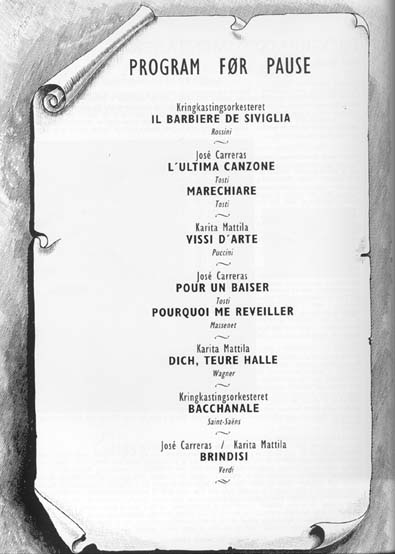

Aftenposten
Dato: 1993-12-17 Utgave: Aften
"Kong Carreras' ariekarriére"
Aftenposten
Dato: 1993-12-19 Utgave: Morgen
"Intim sangkunst i et stort rom"
Aftenposten
Dato: 1993-12-18 Utgave: Morgen
"Supertenor på podiet"
OD Travel
For more reviews from my travels, see www.operaduetstravel.com
If you want to see more photos from my OperaDuets Travels, go to www.operaduetsphotos.com
Posted by
operaduets
at
Sunday, December 17, 2017
0
comments
![]()
Labels: 12_December, 12-17, 1993, Concert, Josep Carreras, Karita Mattila, Norway, Oslo
Thursday, December 14, 2017
December 14, 2009: La Fanciulla del West in Oslo
2009-12-14 La Fanciulla del West (Puccini), Den Norske Opera, Oslo
Minnie = Paoletta Marrocu
Dick Johnson (Ramirez) = José Cura
Jack Rance = Jason Stearns
Nick = Svein Erik Sagbråten
Ashby = Magne Fremmerlid
Jake Wallace = Njål Sparbo
Sonora = Ole Jørgen Kristiansen
Bello = Mads Wighus
Happy = Eirik Roland Egeberg-Jensen
Joe = David Fielder
Jim Larkens = Ketil Hugaas
Trin = Kjell Magnus Sandve
Harry = Henrik Engelsviken
Sid = Espen Langvik
José Castro = Carsten Stabell
Wowkle = Sigrid Ohlsson
Billy Jackrabbit = Bo Elley
Postiglione = Paul Kirkby
Joseph Colaneri, conductor
Monday I had a scare. I heard a woman exclaim "You will love it, I assure you, the Brazilian Helden-Tenor is singing. He is great!!!" Oh, no, I thought, it is not Cura who will sing. But it was the Argentine Tenor who sang.
He was great, Paoletta Marrocu was great. They were all great. I just had a tall man seating in front of me so my seat and view was not too great. But I enjoyed it. People was saying he was even better on Monday 14th than on Saturday 12th. But I had the wrong seat. Viva Argentina!!!!!!!!!!!!
Don't cry for me Argentina! for I will go to Oslo to be there when JC sings his Agentine songs. I am really looking forward to listen to his own songs. Pablo Neruda poems composed by Jose Cura, sung by the composer. And the other songs. Will it be extra songs. I hope for a full house for the Argentine songs with Jose Cura.
Magic will happen again on December 17th. Tomorrow!!!
OD Travel + Photos
Original blog post
For more reviews from my travels, see www.operaduetstravel.com
If you want to see more photos from my OperaDuets Travels, go to www.operaduetsphotos.com
Posted by
operaduets
at
Thursday, December 14, 2017
0
comments
![]()
Labels: 12_December, 12-14, 2009, FANCIULLA DEL WEST, GIACOMO PUCCINI, Jason Stearns, José Cura, Kjell Magnus Sandve, Norway, Opera, Oslo, Paoletta Marrocu
Tuesday, December 12, 2017
December 12, 2009: La Fanciulla del West in Oslo
2009-12-12 La Fanciulla del West (Puccini), Den Norske Opera & Ballet, Oslo
Minnie = Paoletta Marrocu
Dick Johnson (Ramirez) = José Cura
Jack Rance = Jason Stearns
Nick = Svein Erik Sagbråten
Ashby = Magne Fremmerlid
Jake Wallace = Njål Sparbo
Sonora = Ole Jørgen Kristiansen
Bello = Mads Wighus
Happy = Eirik Roland Egeberg-Jensen
Joe = David Fielder
Jim Larkens = Ketil Hugaas
Trin = Kjell Magnus Sandve
Harry = Henrik Engelsviken
Sid = Espen Langvik
José Castro = Carsten Stabell
Wowkle = Sigrid Ohlsson
Billy Jackrabbit = Bo Elley
Postiglione = Paul Kirkby
Joseph Colaneri, conductor
This is a production from Vlaamse Opera Belgium.
Music: Giacomo Puccini
Libretto: Guelfo Civinini og Carlo Zangarini
Director: Robert Carsen
Set design/ costumes: Paul Steinberg
Lighting design: Robert Carsen and Peter van Praet
The Norwegian Opera Chorus
The Norwegian Opera Orchestra
Sung in Italian, Norwegian and English subtitles
Duration: App. 3 hours
It was the first time for me in the new Opera House in Oslo. And it was the first time for Jose Cura in Oslo. He sang Dick Johnson in Puccini's La Fanciulla del West. It is almost one of his calling cards. Among many people also a quite a number of Cura fans. Jose Cura Connexion was well represented there. Old and new friends together.
It was to be a magic night. But at the beginning of the opera I really thought that it would be a boring opera night. I was so totally wrong about that. I have never seen this opera without having moments of boredom but not in Oslo. The Robert Carson production from Vlamse Opera held me in its grip. It was first time I saw this production so I cannot say how much influence the presence of Jose Cura did have to the ensemble of Den Norske Opera. It was no doubt that this was one of Jose Cura finest Dick Johnson. The singing and everything was simply the best Dick Johnson that I have seen Cura do. Paoletta Marrocu was a wonderful actress as Minnie, her voice could be unruly but in sum it was a wonderful Minnie. Jason Stearns as Sheriff Jack Rance was all that one could wish for in this role. Fanciulla del West is not the kind of opera where it is enough to have a great soprano, tenor and baritone. This opera is like Wolf-Ferrari's SLY an opera that needs a great ensemble that can act all it different characters.
Conductor: Joseph Colaneri
Director: Robert Carsen
Set design/ costumes: Paul Steinberg
Lighting design: Robert Carsen and Peter van Praet
This production of La Fanciulla del West, The Girl of the Golden West, started with the men sitting in a cinema seeing a Western film. As the prelude ended in the orchestra the men found there western hats and started to act as they were in a saloon drinking with empty hands and then was shooting with empty hands. I thought that it must be hard to remember all that you must when you don't have the props. But it was just the beginning. When Ashby (Magne Fremmerlid) came then it was really something to drink sat on the table. And when Minnie came, she had real gun. And by then it had started to look as a saloon. And she gave all "real theater" whiskey. By the time the bandit Jose Castro came all had real pistols.
So this production was acted like a fantasy but with each new person coming in a new layer of reality was put in. In the end of the opera it is a dream, the miners go into the cinema to see the western film The Girl of the Golden West after Minnie is now dressed like a movie star and so is Dick Johnson, he came out with a sigarett in his mouth very macho and glamorous.
Nex time. Fanciulla 2009-12-14 and Canciones Argentinas 2009-12-17 in Den Norske Opera & Ballett: www.operaen.no
OD Travel + Photos
Original blog post
For more reviews from my travels, see www.operaduetstravel.com
If you want to see more photos from my OperaDuets Travels, go to www.operaduetsphotos.com
Posted by
operaduets
at
Tuesday, December 12, 2017
0
comments
![]()
Labels: 12_December, 12-12, 2009, FANCIULLA DEL WEST, GIACOMO PUCCINI, Jason Stearns, José Cura, Kjell Magnus Sandve, Norway, Opera, Oslo, Paoletta Marrocu
Saturday, December 9, 2017
December 9, 1988: The Magic Flute in Oslo
1988-12-09 Die Zauberflöte (Mozart), Den Norske Opera (Oslo)
Tamino = Ulf Øien
Nattens Dronning = Benedicte Adrian
Papageno = Per Vollestad
Monostatos = Tor Gilje
Pamina = Itziar Martinez Galdos
Sarastro = Svein Carlsen
Per Åke Andersson, conductor
OD Travel
For more reviews from my travels, see www.operaduetstravel.com
If you want to see more photos from my OperaDuets Travels, go to www.operaduetsphotos.com
Posted by
operaduets
at
Saturday, December 09, 2017
0
comments
![]()
Labels: 12_December, 12-09, 1988, Benedicte Adrian, Itziar Martinez Galdos, Norway, Opera, Oslo, Per Vollestad, Svein Carlsen, Ulf Øien, W.A. MOZART, ZAUBERFLOTE
Thursday, November 30, 2017
November 30, 1989: Faust in Oslo
1989-11-30 Faust (Gounod), Den Norske Opera (Oslo)
Marguerite = Solveig Kringlebotn
Faust = Kåre Bjørkøy
Valentin = Jan Sødal
Mefisto = Oddbjørn Tennfjord
Siebel = Irma Urrila
Marte = Vessa Hanssen
Wagner = Jens Olai Justvik
Dag Nilssen, conductor
For more reviews from my travels, see www.operaduetstravel.com
If you want to see more photos from my OperaDuets Travels, go to www.operaduetsphotos.com
Posted by
operaduets
at
Thursday, November 30, 2017
0
comments
![]()
Labels: 11_November, 11-30, 1989, CHARLES GOUNOD, FAUST, General rehearsal, Jan Sødal, Kåre Bjørkøy, Norway, Oddbjørn Tennfjord, Opera, Oslo, Solveig Kringlebotn


